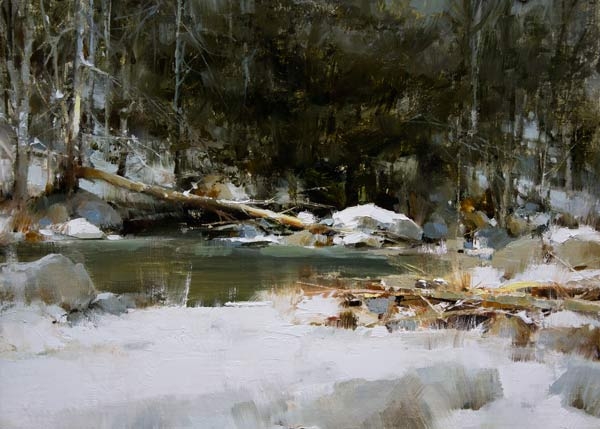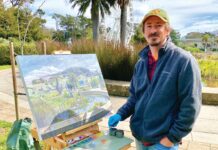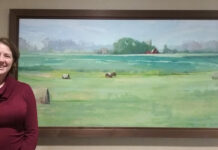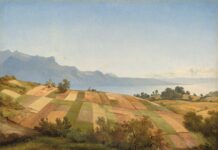Mark Boedges brings years of work and a honed selection of equipment with him to paint outdoors. Like what?
Like both bristle brushes and synthetic mongoose brushes in sizes from 0 to 18.

“Down the Mountain,” by Mark Boedges, oil, 24 x 36 in.
Take a closer look at “A Winter Harmony,” the oil painting that earned Boedges First Place in the December-January 2015 contest of the Plein Air Salon, and you’ll see a variety of textures, brushstrokes, and painting effects. His technique does much to make the scene lively.
Boedges points out that a snow scene on an overcast day is quite muted. The artist lives in Vermont, so he has seen his share of overcast days in winter. And he’s done his share of painting just such subject matter.

“Height of Summer,” by Mark Boedges
“I’ve worked on getting down this kind of scene for years,” says Boedges. “In sunlit scenes, there’s all kinds of color happening. When it’s overcast, everything flattens out and you lose a lot of color. It’s almost like photography does a better job in this kind of situation.”
Boedges says that in sunlight, snow takes on many colors, but it’s much more subtle on cloudy days. His solution is to pull out a few bright spots, and play up the color that is there. “I have to rely on the trees and grasses,” he says. “The snow had mostly fallen from the trees, so there was a good balance.” Deadfall in the foreground gave Boedges additional opportunity to paint some warm colors into the picture.

“Our Start,” by Mark Boedges, oil, 18 x 30 in.
The bit of bright white on the rock near the center of the composition may look straight out of the tube, but Boedges says it is white mixed with a tiny bit of phthalocyanine blue — he finds most tube whites too yellow. If that accent seems like it was applied by a palette knife, it probably was. Boedges uses a medium-size trowel-shaped palette knife with a bent neck for parts of his painting process.
In fact, Boedges utilizes various tools at various times to give his paintings a complicated sense of texture and depth. He described his process for this particular piece, which is representative of his approach. Boedges first applied a thin wash of color with a bristle brush to set the composition. He then applied thicker paint with a synthetic mongoose brush to establish the tree trunks and similar elements.
Boedges moves around the surface, allowing a section to dry a bit before returning to it. This allows him to go back with a bristle brush to add texture to trees, to suggest grasses, and the like, with a drybrush technique. Passages painted with the palette knife offer another kind of texture and experience, along with an efficient way of painting lines, such as thin branches.

“Early Winter Cover,” by Mark Boedges, oil on linen, 12 x 16 in.
“If it’s not too cold, I can stay out there for four hours painting,” says Boedges. “There’s scale at work here — these techniques are great for smaller pieces. But I can’t stand out there and paint branch by branch. In the end, I want it to look kind of like what it looks like in reality, but not branch by branch.”
Boedges is clearly a person who has investigated which tools work best for him. But his answers to questions, and even more so his paintings, indicate that the most important thing in his toolbox is experience. He has tried various methods, analyzed his work, built upon his discoveries, and learned when to let things stand. “You rely on a whole lot of happy accidents for a successful painting,” says Boedges. “And it took years to get all those happy accidents to land just right.”

“Cliff House,” by Mark Boedges, oil, 20 x 24 in.
The next round of the Plein Air Salon has begun so hurry, as this competition ends soon. Enter your best art in the Plein Air Salon here.
New This Year! We’re now offering a People’s Choice Award in each monthly cycle, with a prize of $100! (When you enter your painting, you’ll be able to “promote your artwork” with a special link.)
About the Plein Air Salon:
In the spirit of the French Salon created by the Academie des Beaux-Arts in Paris, this annual competition, with monthly cycles leading to annual Salon Grand Prize winners, is designed to stimulate artistic growth through competition. The competition rewards artists with $30,000 in cash prizes and exposure of their work, with the winning painting featured on the cover of Plein Air magazine.
It is our belief that cash prizes provide further inspiration and an avenue for artists to thrive and create new work by helping alleviate financial pressure.
Winners in each monthly competition may receive recognition and exposure through Plein Air magazine’s print magazine, e-newsletter, and social media. Winners of each monthly competition will also be entered into the annual competition.
Related Article > 3 Secrets to Winning Art Competitions





